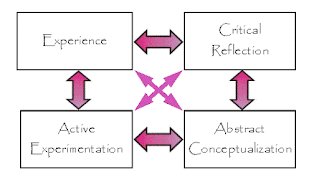101. The Transformative Power of AI
.jpg)
.jpg)
 What went well during remote learning? What did not go well?
What went well during remote learning? What did not go well?
How do I know it went well? What data or evidence do I have to guide my reflection?
How can I use the answers to these questions to improve my course design?
Here are six things that learned from my student surveys:
1. We were already using a Learning Management System, Canvas. This was HUGE! The capabilities were much more robust than Google Classroom. Plus, the students already knew how to use it! The last thing I wanted to do during a pandemic was learn a new computer program.
2. The students really liked having a landing page on Canvas. I posted a weekly calendar and they only had to click on one daily link and everything they needed was there. They could access multiple platforms (EdPuzzle, FlipGrid etc) from one page.
3. The expectations for "remote learning" were clearly established at the beginning of the school year. The students had been participating in flex days throughout the year. Therefore, they knew how to access their course materials and turn in assignments remotely. This is not an intuitive process and, fortunately, we had been practicing these skills all year long.
4. The students indicated on their surveys that they enjoyed lessons that included short videos like Ted Talks or YouTube. I paired them with tools that forced engagement like EdPuzzle, Flipgrid and Quizlet. They craved interaction and feedback! If you are interested in learning more about tech tools, I suggest you check out this post, App Smashing Tech Tools, written by my school's Instructional Coach, Stephanie Sukow.
5. The students wanted more direct instruction. I will be exploring the flipped model of direct instruction in my next blog post. The flipped classroom model consists of the students learning the content prior to an in-class discussion or application. It is a flexible model that works wherever the students are learning.
6. The students really enjoyed having control over the timing of their assignments. I set my assignments up so they unlocked at midnight and the students had 24 hours before the next assignment was posted. Some of my students stayed up late and completed them before they went to bed. Some students were early risers and had them completed by 8 am. Some of my students were working a ton of hours and they liked being able to complete them on their days off. The important takeaway here is that the materials were accessible to the students, when they needed them.
Based on this information, what am I going to keep, toss or revise for next year?
We will spend a lot of time becoming familiar with the Canvas platform and other other tools as this was key to my students' success .
I will develop alternative ways to provide content to my classes. This includes developing some flipped lessons that can be used in the physical classroom and remotely.
I will incorporate different tools like retrieval practice into my online classroom. These will provide a rich source of data for me to measure student understanding.
I challenge you to reflect on what worked and didn't work in your own remote classroom. Be sure to write it down! Determine what data or evidence you have to help guide your reflection. Did you administer a survey? Did your school? What does the data reveal about student engagement and learning? Then, put it away until you are ready to start planning for next year.
Adaptability and flexibility are essential to our success in the upcoming year. Over the next few weeks I will be sharing some easily implemented strategies that can help you make your classroom more accessible. Click on the subscribe button at the top of the page and you will be notified when my next post is posted.
Please let me know if you have any questions or comments. I'd love to hear from you!
Comments
Post a Comment